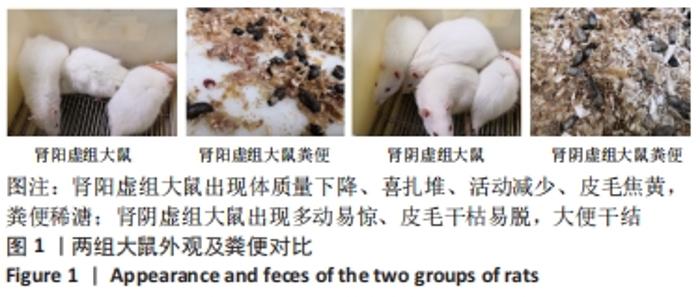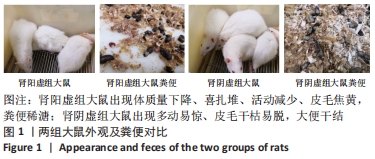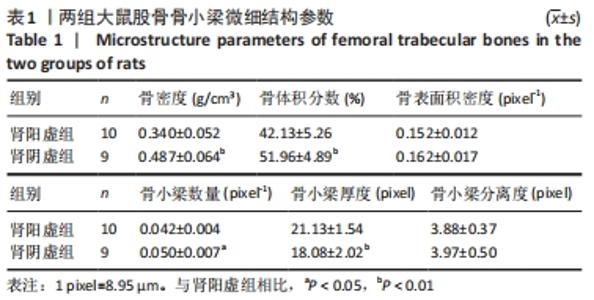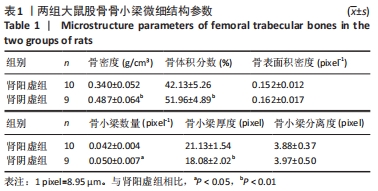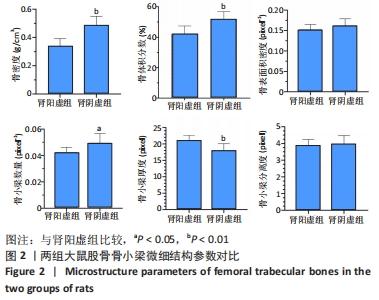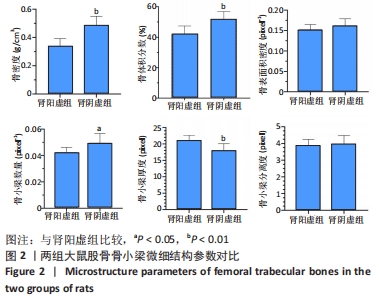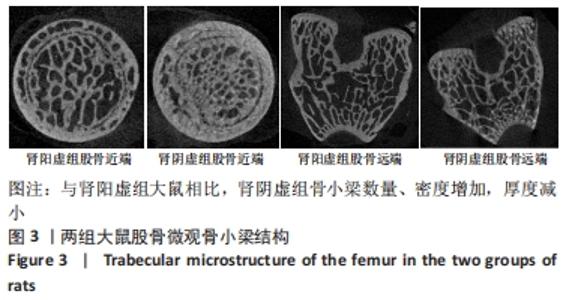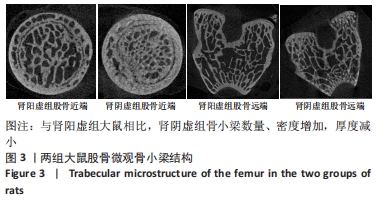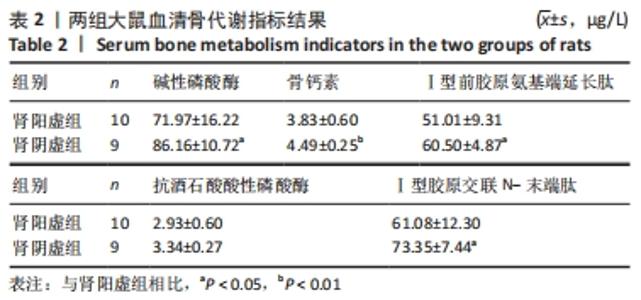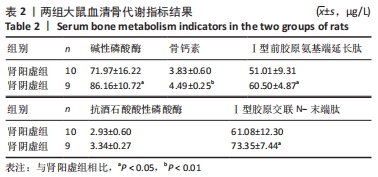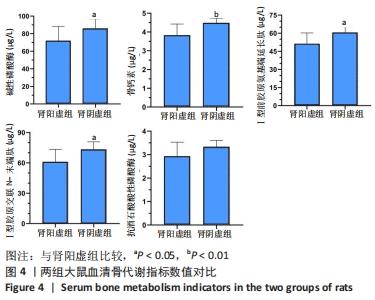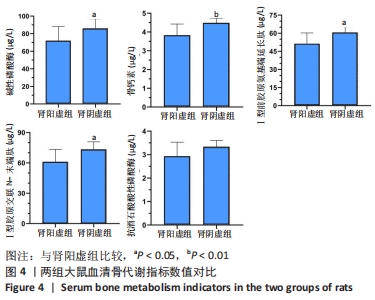[1] LIN X, XIONG D, PENG YQ, et al. Epidemiology and management of osteoporosis in the People’s Republic of China: current perspectives. Clin Interv Aging. 2015; 10:1017-1033.
[2] BLACK DM, ROSEN CJ. Clinical Practice. Postmenopausal Osteoporosis. N Engl J Med. 2016;374(3):254-262.
[3] COUGHLAN T, DOCKERY F. Osteoporosis and fracture risk in older people. Clin Med (Lond). 2014;14(2):187-191.
[4] 孙凯,魏戌,朱立国,等.病证结合模式下骨质疏松症实验动物模型的研究进展[J].中国骨质疏松杂志,2019,25(9):1340-1344.
[5] 葛继荣,王和鸣,郑洪新,等.中医药防治原发性骨质疏松症专家共识(2020)[J].中国骨质疏松杂志,2020,26(12):1717-1725.
[6] 王振昊,林涨源.葛根素联合锌治疗去势大鼠骨质疏松症的实验研究[J].中华全科医学,2019,17(9):1450-1453.
[7] 张悦,李运峰.骨质疏松症动物模型研究进展[J].中国骨质疏松杂志,2020, 26(1):152-156.
[8] 张子怡,陈宝军,张英杰,等.肾阳虚、肾阴虚证大鼠模型的建立与稳定性观察[J].福建中医药,2015,46(1):51-54.
[9] 黄越燕.病证结合动物模型的研究现状与思考[J].世界中西医结合杂志,2018, 13(10):1459-1462.
[10] 彭紫凝,邢玉凤,庞欣欣,等.病证结合动物模型研究进展[J].世界科学技术-中医药现代化,2020,22(7):2211-2216.
[11] 陈英华,欧阳轶强,孙琪,等.肾阳虚证动物模型规范化研究中诊断指标选择的初步探讨[J].中国中医基础医学杂志, 2003,9(10):26-30.
[12] 张晓文,马应卓,朱佳丽,等.橙皮苷对去卵巢骨质疏松症大鼠骨质流失和机制的影响[J].中国骨质疏松杂志,2021,27(9):1283-1288.
[13] 杜江,李楠,王和鸣.肾虚模型造模方法及相关指标[J].中国组织工程研究与临床康复,2010,14(50):9433-9436.
[14] 梁汝圣,徐宗佩.大鼠肾阴阳虚模型建立方法[J].吉林中医药,2008,28(9):685-687.
[15] 卢文丽,方肇勤.阳虚证动物模型诊断指标与评析[J].上海中医药杂志,2005, 39(4):42-46.
[16] 潘向军,楼百层,朱延涛.肾阴虚模型制备方法及肾阴虚证研究进展[J].新中医,2019,51(3):23-27.
[17] 张英杰.基于肾阴虚、肾阳虚状态人骨组织差异蛋白质组探讨“肾主骨”理论[D].福州:福建中医药大学,2017.
[18] 任威铭,战丽彬.历年阴虚证诊断标准类文献比较与分析[C].郑州:中国中西医结合学会慢病防治与管理专业委员会成立大会暨世界中医药学会联合会老年医学专业委员会第七届学术年会——新时代·推进老年慢病防治与管理, 2018.
[19] 任珍,彭孟凡,苗明三.中医药动物模型评价方法的现状与思考[J].中药药理与临床,2020,36(4):219-222.
[20] 秦义.基于混合方法研究的肾阳虚证诊断标准的制定与评价[D].北京:中国中医科学院,2020.
[21] 原雪,李福凤,王忆勤.肾阴虚证本质的现代医学研究进展[J].辽宁中医杂志,2012,39(9):1875-1877.
[22] XIUFENG W, LEI Z, RONGBO H, et al. Regulatory mechanism of hormones of the pituitary-target gland axes in kidney-Yang deficiency based on a support vector machine model. J Tradit Chin Med. 2015;35(2):238-243.
[23] 申浩,蒋红岩,章轶立,等.骨质疏松症患者中医证候与骨代谢标志物相关性研究[J].中国中医基础医学杂志,2021,27(6):970-972.
[24] 詹正烜,郑乃熙,张英杰,等.肾阴虚、肾阳虚模型大鼠股骨皮质骨差异蛋白质表达的分析[J].中国中西医结合杂志,2017,37(10):1242-1247.
[25] 李冠武,汤光宇. Micro-CT及~1H-MRS在骨质疏松骨质量研究中的应用[J].国际医学放射学杂志,2010,33(6):525-528.
[26] 许宋锋,王臻. Micro-CT在骨科的应用和进展[J].中国骨肿瘤骨病,2004,3(4): 236-241.
[27] 刘蓉,郭新路,张亚坤,等.骨小梁Micro-CT图像形态计量学参数计算方法综述[J].中国生物医学工程学报,2018,37(2):237-246.
[28] 李悦.基于骨代谢探讨肾阴虚证与肾阳虚证PM0P的差异及两种补肾法的干预机制[D].广州:广州中医药大学,2015.
[29] GU F, JIANG J, WANG S, et al. An experimental research into the potential therapeutic effects of Anti-Osteoporosis Decoction and Yougui Pill on ovariectomy-induced osteoporosis. Am J Transl Res. 2019;11(9):6032-6039.
[30] 张萌萌,张岩,吴涤,等.骨代谢生化指标实验推荐方案[J].中国骨质疏松杂志,2021,27(10):1445-1412,1549.
[31] 陈栋炜,蒙一纯,方湘娟,等.肾阳虚证本质的现代医学研究进展和展望[J].现代中西医结合杂志,2005,14(23):3175-3177.
[32] 钱洪爽,沃兴德.肾阳虚证本质的中西医结合研究[J].吉林中医药,2010,30(4): 298-300.
[33] 李生强,冯尔宥,谢冰颖,等.原发性骨质疏松症肾阳虚证骨组织全基因表达谱研究[J].中国骨质疏松杂志,2017,23(7):846-850.
[34] 郑绍勇,丁成华.基于肾阴虚证现代文献病证结合研究[J].中医临床研究, 2017,9(3):80-82.
[35] 吴义忠,吴勋,周丽君.骨代谢生化指标在类风湿性关节炎骨质疏松症中的意义[J].吉林医药学院学报,2020,41(3):195-196.
|
